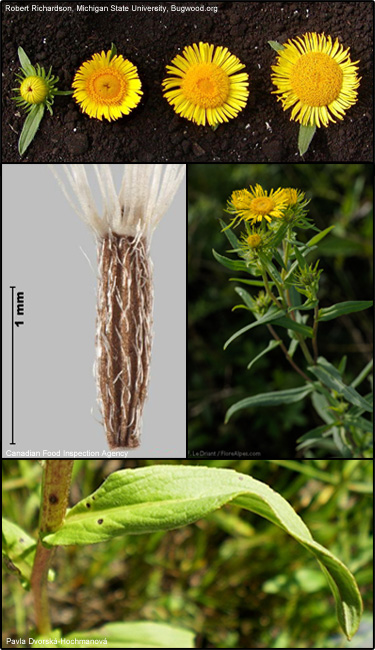British yellowhead (Inula britannica)
 Description: Primarily found in Hosta plants imported from the Netherlands. Currently listed on the Federal Noxious Weed List.
Description: Primarily found in Hosta plants imported from the Netherlands. Currently listed on the Federal Noxious Weed List.Habit: Erect, herbaceous plant that grows from 6-30 in. tall.
Leaves: Lanceolate to elliptical, sessile, may become clasping towards the top. Sparsely pubescent
Stems: Sparsely pubescent on the upper surface and densely pubescent on the lower surface. Margins are smooth to finely toothed. Lower leaves are elliptical or ovate-elliptical in shape, 1.5-6 in. long and 0.4 to 1 in. wide with a narrow or short stalk. Upper leaves have no stalk or may clasp the stem and are rounded at the base.
Flowers: Yellow in color, daisylike, occur along or in clusters of 2 or 3. Medium to large flowerheads that are 0.8 to 1 inch across. Bracts are linear and in 2 rows, green in color and soft. Rays are long and narrow. Surrounded by a single pappus (extremely fine hairs); bloom from July to August.
Fruit and seeds: Achene.
Habitat: Native to Europe. Can be found in moist habitats such as river and streambanks, marshes, ditches, wet grassland, and wet woods.
Reproduction: By seed, short rhizomes and root fragments.
Credits: The information provided in this factsheet was gathered from the Alabama Cooperative Extension System ANR-1227.
Individual species images that appear with a number in a black box are courtesy of the Bugwood.org network (http://www.invasive.org). Individual photo author credits may not be included due to the small display size of the images and subsequent difficulty of reading the provided text. All other images appear courtesy of Google (http://images.google.com).
Common Name: | British yellowhead |
Scientific Name: | Inula britannica |
Family: | Asteraceae (Aster) |
Duration: | Perennial |
Habit: | Herbs |
USDA Symbol: | INBR |
